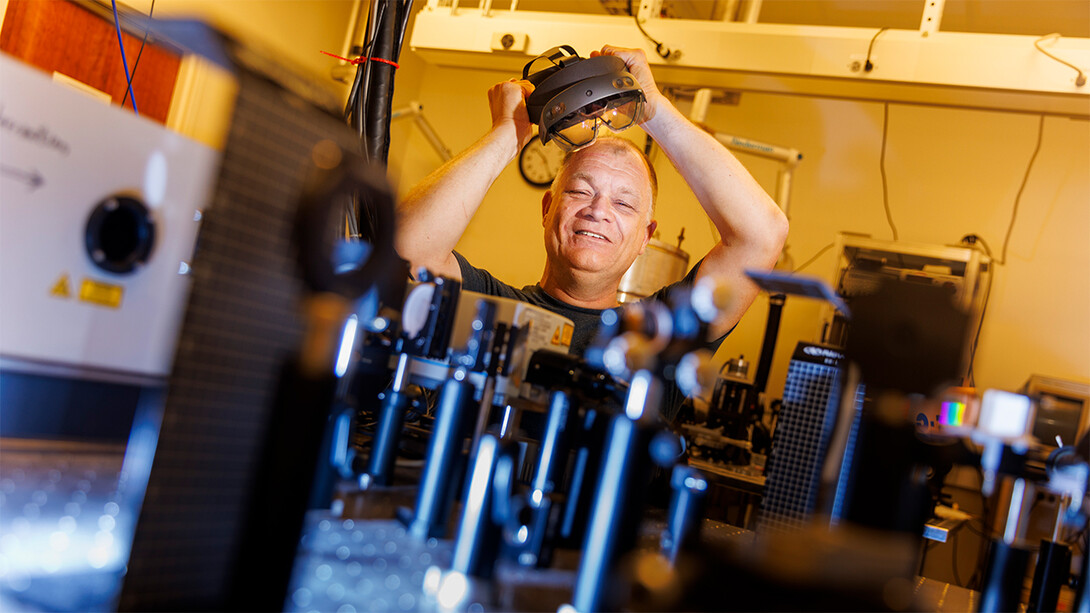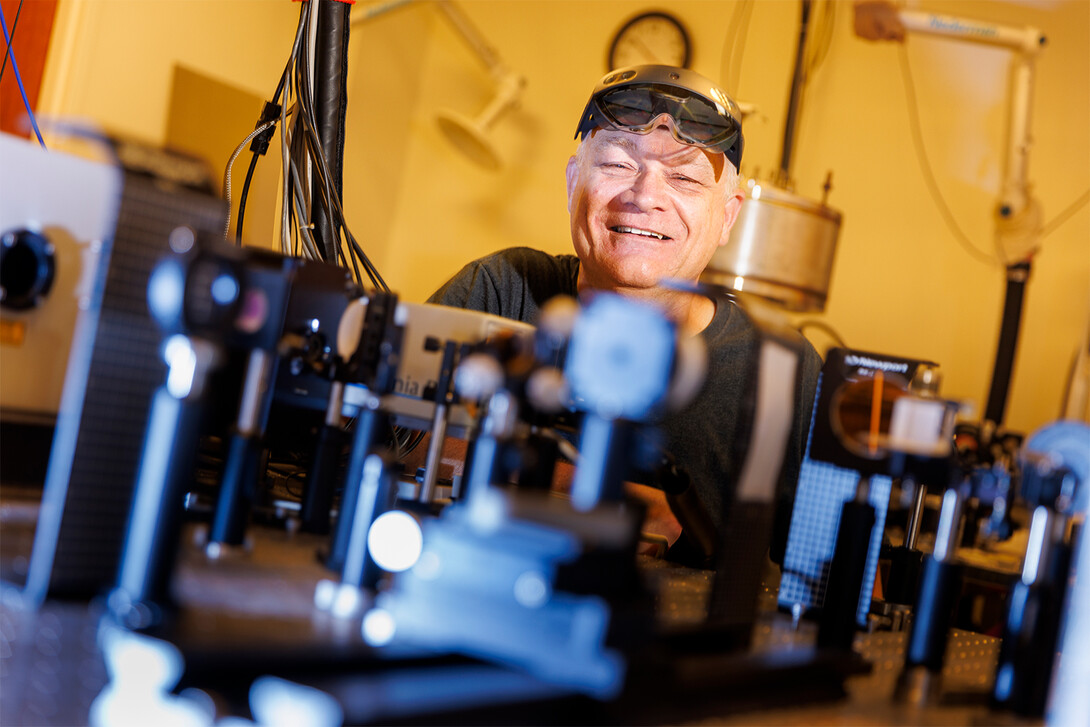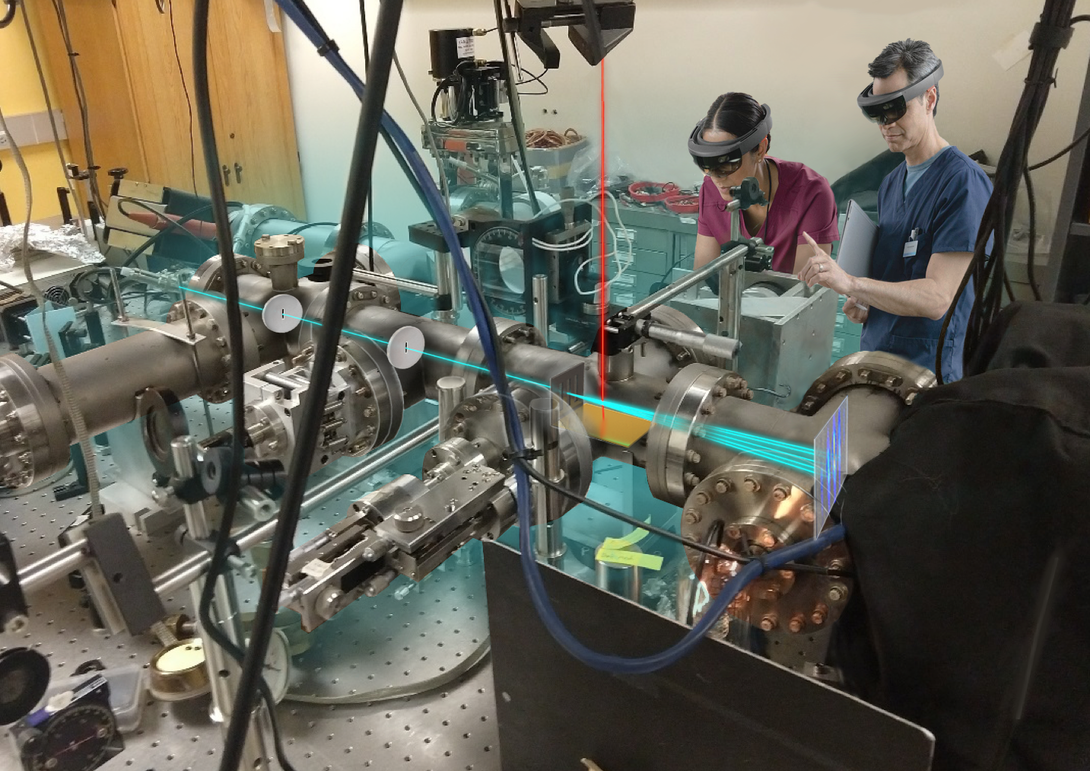
Viewing the invisible. Shrinking to the subatomic level. Understanding the realm of the tiny, where the constants of everyday, intuitive, apple-falling physics yield to uncertainties, probabilities and paradoxes that sometimes break the brains of even those who study them — who study quantum mechanics.
As one of the relatively few people on the planet who really comprehends those mechanics of the minuscule, Cornelis “Kees” Uiterwaal has long wanted others to see the wonders of his field the way he sees them in his head.
“There are a lot of times in physics and quantum mechanics, in particular, where you’re dealing with things that you can’t imagine, because you have no analogies (for them) in your daily life,” said Uiterwaal, associate professor of physics and astronomy at Nebraska. “So I’ve been thinking about that for a long time. How can you visualize that?”
Then he learned about augmented reality: technology that allows the wearer of a headset to view and interact with computer-generated, three-dimensional objects in the physical world. Thanks to a two-year, $629,692 grant, Uiterwaal and a multidisciplinary cadre of colleagues are now developing AR experiences that will explain the principles, and hopefully convey the awe, of the physical phenomena taking place on the smallest of scales.
The new project — Quantum Business, Arts and Science for Society, or Q-BASS — comes courtesy of Nebraska U’s Grand Challenges Catalyst Competition. That four-year, $40 million effort will address what Chancellor Ronnie Green, the Office of Research and Economic Development, and the Husker community have identified as seven of the “wicked problems” facing society. Two of those seven themes? Quantum Science and Engineering, where Uiterwaal’s expertise lies, and Science and Technology Literacy for Society, where the augmented reality comes in.
Though Uiterwaal had known about AR for a while, it wasn’t until meeting Jesse Fleming, founding director of the Awareness-Based Design Lab at Nebraska’s Johnny Carson Center for Emerging Media Arts, that he began to grasp its true promise for quantum physics. Not long after, with support from the Carson Center and Department of Physics and Astronomy, the pair was creating a straightforward AR experience that essentially served as a proof-of-concept for Uiterwaal’s vision.
“I was fascinated, because it’s one thing to have a vision in your head,” Uiterwaal said. “It’s something really different to then see it as you would hope it to be. And still, there’s so much to explore. I literally crawled under it to make sure that, yes, it was 3D. It was a fantastic experience.”
That demonstration supported what Uiterwaal had suspected: that color and sound, “which have little meaning on the quantum scale,” could nevertheless engage people enough to help them overcome aversions to physics that might otherwise impede learning and literacy.
“Our feeling is that if something is visually, artistically impressive, you’re more inclined to open your mind to it,” Uiterwaal said. “You become susceptible to more complicated or different kinds of ideas.
“The moment you’ve captured people’s minds there, you have them open to understanding more.”
The duo has since recruited Husker physicist Herman Batelaan, chemist Alena Moon and multimedia artist Jinku Kim, plus the University of Nebraska Omaha’s Chris Moore, to help create and assess the educational value of quantum-focused AR experiences.

One of those experiences will focus on recreating the double-slit experiment, which famously demonstrates one of the most counterintuitive aspects of quantum mechanics: Electrons and other quantum entities, including light, can simultaneously behave like both particles and waves. One version of the experiment involves pointing an electron-firing device at a screen that lights up wherever it gets struck by those electrons. Between the electrons and the screen stands a wall with two vertical slits that allow the electrons to pass.
If electrons behaved only as particles, the experimenter would expect to see a simple pattern — two bright pillars behind their respective slits — to emerge on the screen. Instead, the experiment generates multiple pillars of brightness that are separated by gaps of relative darkness. As it turns out, that’s essentially the same pattern that emerges when waves, including ripples of water, interfere with each other. Stranger still? When the electrons are recorded passing through one slit or the other, that interference pattern fails to emerge, instead yielding the simpler two-pillar pattern expected from particle behavior alone.
The team’s AR experience will incorporate data — the locations of actual electrons striking an actual screen — from a Batelaan-designed version of the experiment, Uiterwaal said. In fact, the entire experience will be superimposed on Batelaan’s lab in Jorgensen Hall. But the AR will also slow down those speed-of-light electrons to a leisurely pace, make them visible to the human eye, and feature cinematic flourishes that accompany the science behind all the weirdness. All the while, a headset-wearing user can walk around or through the scene, effectively acting as their own cinematographer.
“Maybe you hear a sound when an electron impacts the screen: ‘Booooommm!’” Uiterwaal said, mimicking the noise in his mind’s ear. “We have a composer on board whom we hired specifically for that purpose.”
Moon and Moore, meanwhile, will be testing how well AR experiences help students learn the scientific principles at their cores. Prior studies from Moon’s group have revealed how much students can struggle to avoid mapping large-scale, Newtonian physics onto the bizarre outcomes of quantum mechanics, as when wondering whether the dark gaps of the double-slit experiment might be shadows. With that in mind, Moon’s group will interview students following their AR experiences to gauge their “real-time sensemaking” of different scales, from the quantum to the microscopic to the macroscopic.
“If you make a product, it’s very easy to become convinced that it’s going to be a useful tool, because you like it so much, and you invested so much time and money and work in it,” Uiterwaal said. “But we want to know if it really is effective.”
Though the Q-BASS project is in its infancy, Uiterwaal is already thinking ahead. When he first began doing his homework on science-focused AR, he struggled to find much in the way of experiences that covered physics of any kind, let alone quantum mechanics.
“There’s content in technology, where technicians are trained to take apart some complicated motor or part of equipment, virtually, so they can learn in a more effective, direct way,” Uiterwaal said. “And in medicine, you can take a heart apart and show it to your students. But in physics, there’s an absolute lack of content.”

Uiterwaal sees an opportunity to launch a startup company that could fill the void with the very sorts of physics-based AR experiences that his team is now busy creating. Before he goes any further, though, he’s taking a course from NUtech Ventures, the university’s technology commercialization affiliate, that walks prospective entrepreneurs through the paces of analyzing a market — in this case, the AR market. Though it’s “anything but a crowded one” on the physics front, Uiterwaal has clearly absorbed the lesson that supply means little without demand.
“If you want to have a successful startup, it is best to not talk about your technology, but first to talk about what problems your customers have that they need to solve,” Uiterwaal said. “So we’re taking this course, and based on that, hope to develop a product that satisfies their needs instead of just making a product, going to people, and saying, ‘Look, this is cool.’”
Which is not to say that Uiterwaal lacks for ideas. If the right publishers were open to it, he could imagine a future in which his team integrates AR into textbooks on quantum physics. Maybe, instead of poring over the usual esoteric diagrams on atomic dynamics, students would be instructed to load up a specific program, slip on their AR headsets, and watch as atoms hover above their textbooks. Rather than trying to make meaning from a static, 2D representation, students would find themselves watching, rewinding, rotating and zooming in on those 3D dynamics in action.
The price must be right, of course, and Uiterwaal said it might prove prohibitive, at least for now. But AR technology, like all technology, will only drop in price. When it does, he aims to be ready.
“We’re still far away from that,” he said. “But ultimately, our goal is to really open this up to a much wider audience.”







